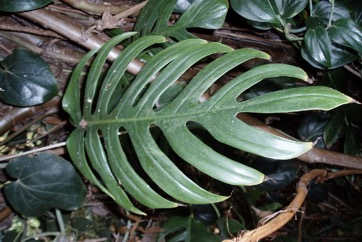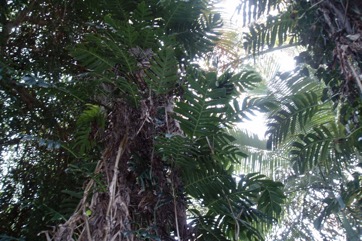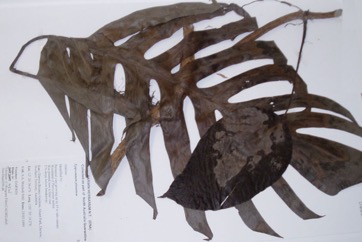False Monsteriosa, Native Monstera

A tropical and subtropical plant. It grows best with warm conditions and high humidity. It is best with light shade. It is damaged by drought and frost. They need good drainage. It suits hardiness zones 10-12. In Yunnan. It occurs in the Western Ghats in India.
Also known as:
Devil's ivy, Dragon tail, Ekor naga, Fue laufao, Galgalut, Jalu mampang, Lolo munding, Lolo tali, Pothos, Rawalu, Sulang, Taro vine, Yalu
Synonyms
- Epipremnum mirabile Schott.
- Monstera dilacerata (K. Koch & Sello) K. Koch
- Pothos pinnata Linnaeus
- Rhaphidophora pinnata (L.) Schott.
- Scindapsus pinnatus Schott
- and several others
Edible Portion
- Leaf stalk starch, Fruit
Where does False Monsteriosa grow?
Found in: Amazon, Asia, Australia, Bangladesh, Belize, Bolivia, Brazil, Brunei, Cambodia, Central America, China, Colombia, Cook Islands, Costa Rica, Dominican Republic, East Timor, Fiji, Hawaii, Guatemala, Honduras, India, Indochina, Indonesia, Laos, Malaysia, Marquesas, Myanmar, Nauru, Nicaragua, Pacific, Panama, Papua New Guinea, PNG, Peru, Philippines, Puerto Rico, Samoa, SE Asia, Singapore, Solomon Islands, South America, Taiwan, Thailand, Timor-Leste, Tonga, Tuvalu, United States, Vanuatu, Venezuela, Vietnam, West Indies
Notes: There are 15-18 Epipremnum species. It can be invasive.
Status: It is used on Pentecost Island, Vanuatu.
Growing False Monsteriosa, Native Monstera
Cultivation: It is grown from runners which are put in water to form roots. Plants need then to be put in shady humid situations and can be trained to climb up trees. Plants can be grown from fresh seed or from stem cuttings.
Edible Uses: Starch is extracted from the leaf stalk. CAUTION The sap can irritate the skin.
Production: In Australia it flowers in December to March.
Nutrition Info
per 100g edible portion| Edible Part | Energy (kcal) | Protein (g) | Iron (mg) | Vitamin A (ug) | Vitamin c (mg) | Zinc (mg) | % Water |
|---|---|---|---|---|---|---|---|
| - | - | - | - | - | - |
False Monsteriosa, Native Monstera Photos



References
Barrau, J., 1976, Subsistence Agriculture in Melanesia. Bernice P. Bishop Museu, Bulletin 219 Honolulu Hawaii. Kraus reprint. p 50
Bodkin, F., 1991, Encyclopedia Botanica. Cornstalk publishing, p 385
Burkill, I.H., 1966, A Dictionary of the Economic Products of the Malay Peninsula. Ministry of Agriculture and Cooperatives, Kuala Lumpur, Malaysia. Vol 1 (A-H) p 946
Cabalion, P. and Morat, P., 1983, Introduction le vegetation, la flore et aux noms vernaculaires de l'ile de Pentcoste (Vanuatu), In: Journal d'agriculture traditionnelle et de botanique appliquee JATBA Vol. 30, 3-4
Cooper, W. and Cooper, W., 2004, Fruits of the Australian Tropical Rainforest. Nokomis Editions, Victoria, Australia. p 60
Cowie, I, 2006, A Survey of Flora and vegetation of the proposed Jaco-Tutuala-Lore National Park. Timor-Lests (East Timor) www.territorystories.nt/gov.au p 43
Cundall, P., (ed.), 2004, Gardening Australia: flora: the gardener's bible. ABC Books. p 543
Flora of Pakistan.
Fouqué, A. 1972. Espèces fruitières d'Amérique tropicale. Institut français de recherches fruitierès outre-mer (ifac) (As Monstera dilacerata)
Franklin, J., Keppel, G., & Whistler, W., 2008, The vegetation and flora of Lakeba, Nayau and Aiwa Islands, Central Lau Group, Fiji. Micronesica 40(1/2): 169–225, 2008
French, B.R., 2010, Food Plants of Solomon Islands. A Compendium. Food Plants International Inc. p 328
Gillaumin, R., 1954, Les Plantes utiles des Nouvelles-Hebrides (fin et complement) In: Journal d'agriculture tropicale et de botanique appliquee Vol. 1, No. 10-12 pp 453-460
Hiddins, L., 1999, Explore Wild Australia with the Bush Tucker Man. Penguin Books/ABC Books. p 154 (As Rhaphidophora pinnata)
Hibbert, M., 2002, The Aussie Plant Finder 2002, Florilegium. p 93
Jackes, B.R., 2001, Plants of the Tropics. Rainforest to Heath. An Identification Guide. James Cook University. p 41
Jones D, L, 1986, Ornamental Rainforest Plants in Australia, Reed Books, p 287
Kermath, B. M., et al, 2014, Food Plants in the Americas: A survey of the domesticated, cultivated and wild plants used for Human food in North, Central and South America and the Caribbean. On line draft. p 545 (As Monstera dilacerata)
Leiper, G & Houser, J., Mutooroo. Plant Use by Australian Aboriginal People. Assembly press, Queensland. (As Rhaphidophora pinnata)
Liefting, A., et al, Samoan plant names. http://en.wikipedia.org
Llamas, K.A., 2003, Tropical Flowering Plants. Timber Press. p 83
Marinelli, J. (Ed), 2004, Plant. DK. p 453
Massal, E. and Barrau, J., 1973, Food Plants of the South Sea Islands. SPC Technical Paper No 94. Noumea, New Caledonia. p 40
Nicholson, N & H., 1994, Australian Rainforest Plants 4, Terania Rainforest Publishing. NSW. p 32
Peekel, P.G., 1984, (Translation E.E.Henty), Flora of the Bismarck Archipelago for Naturalists, Division of Botany, Lae, PNG. p 68, 69
Pflanzenr. IV. 23B(Heft 37):60. 1908
Ratcliffe D & P., 1987, Australian Native Plants for Indoors. Little Hills press. p 125 (As Rhaphidophora pinnata)
Staples, G.W. and Herbst, D.R., 2005, A tropical Garden Flora. Bishop Museum Press, Honolulu, Hawaii. p 604 (Drawing)
Sukarya, D. G., (Ed.) 2013, 3,500 Plant Species of the Botanic Gardens of Indonesia. LIPI p 925
Thaman, R. R., et al, 1994, The Flora of Nauru. Atoll Research Bulletin No. 392. Smithsonian Institute p 42 (As Epipremnum aureum)
Thaman, R. R, 2016, The flora of Tuvalu. Atoll Research Bulletin No. 611. Smithsonian Institute p 40
Townsend, K., 1994, Across the Top. Gardening with Australian Plants in the tropics. Society for Growing Australian Plants, Townsville Branch Inc. p 181
World Checklist of Useful Plant Species 2020. Royal Botanic Gardens, Kew
Yuncker, T.G., 1959, Plants of Tonga, Bernice P. Bishop Museum, Hawaii, Bulletin 220. p 75